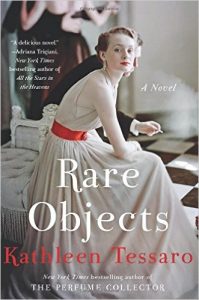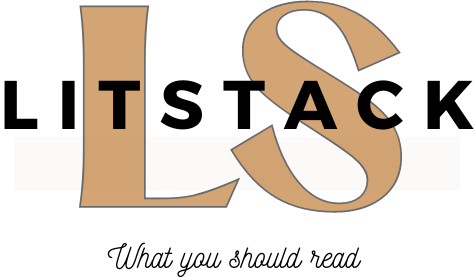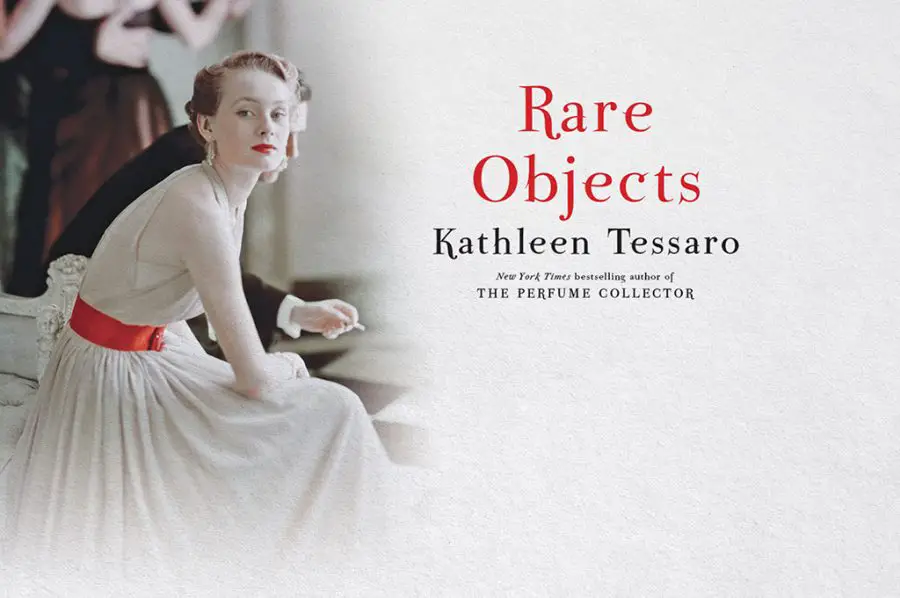 Rare Objects
Rare Objects
Kathleen Tessaro
Harper
Release Date: April 12, 2016
ISBN 978-0-0623-5754-0
In 2013, Kathleen Tessaro’s novel, The Perfume Collector, became one of my favorite reads of all time despite it not falling within the parameters of my preferred genre. Now, three years later, her newest book has been released, and while it doesn’t hold the smoke and spark of The Perfume Collector, it still is a lovely and very enjoyable read.
Rare Objects is the story of Maeve Fanning, a first-generation Irish immigrant in Depression-era Boston. Maeve is beautiful, spirited, intelligent and witty; she is also hemmed in by her broken family, her working class status, and her Irish heritage. In a bid for independence, she tries to make her way in New York City but is derailed by a fondness for gin and the men who usually accompany it. After spending time in an asylum after an abortive suicide attempt, she returns home, telling her friends that New York was simply too big for her.
Desperate for a job, she bleaches her hair blonde, drops her brogue and dons the Anglican name May; the gambit pays off and she finagles her way into the position of shop girl at Winshaw and Kessler, an antiques shop that caters to New England’s elite. From portly Mr. Kessler she learns not only the value of the antiques in the shop, but also the value of rare things – and that being able to spin stories increases the value of any object.
A chance encounter with someone from her past catapults Maeve into a world beyond her imagining – the upper crust of Boston’s moneyed families, and she breathlessly dances across her various lies and feints in order to leave her own past behind. But when that beautiful world tarnishes and her own values are challenged by the restless, globe-trotting co-owner of the antiques shop, Mr. Winshaw, Maeve must decide how far she’s willing to go to make her own dreams come true.
On the surface, Rare Objects is about a young woman’s journey towards self-awareness, but at its heart it’s about looking beyond appearances to see the deeper value of objects, and of people. While we can expect this from Maeve’s story, it resonates throughout the book. Take, for example, Maeve’s mother, a staunchly Catholic widow who has worked as a lowly seamstress at a high-end department store for years. Early on we learn that she is constantly being passed over for promotion to the sales floor, not because she is Irish, but because her impeccable tailoring skills make her irreplaceable in that less valued position.
Tangentially, the book also explores how stories can heighten the perceived value of a rare object, and that damage does not necessitate a lessening of value of any given item. It all has to do with perspective and perception. As Mr. Kessler explains to a newly hired Maeve:
“I have one man who only wants to buy rare porcelain that’s been repaired in some unusual way, long before the days of glue. Exquisite teapots with ugly twisted silver spoons for handles, platters held together by metal staples and twine, broken glassware with shattered bases replaced by hand-carved wooden animals. Actually, I have to admit, as an anthropologist, he’s one of my favorites.” He leaned against the counter. “You see, a well-curated collection always tells a story. His tells a tale of resourcefulness and industry; of people who had the foresight to salvage something even though it will never be pristine again. I like to think of it as the moment when aspiration meets reality.”
The antique shop gives a perfect platform for these lessons, but it’s up to us to find those lessons mirrored throughout the novel. It is through Ms. Tessaro’s consummate skill that while they are employed liberally, we are almost oblivious to their reinforcement because we are so swept up in the unfolding story of these marvelous, complex characters.
As for atmosphere, Rare Objects shines. The depiction of Depression-era Boston, from its immigrant communities to the hidden nightclubs to the posh enclaves of the rich and famous simply crackle. Maeve’s North End working class neighborhood, especially, comes to life under Ms. Tessaro’s gracious care. Once a bastion of Irish immigrants, the Italians took over the North End when the Irish migrated further south. Maeve’s mother, however, stubbornly refuses to leave her familiar apartment, so Maeve grows up versed in both Irish and Italian traditions – something that she finds both comforting and cloying.
The one thing in the book that gave me pause was just how many fairytale coincidences had to be place to drive the story forward: Maeve just happens to cross paths with a person of high standing and then just happens to land a job that she wasn’t qualified for that just happens to allow her to interact with persons of high standing who just happen to take an interest in her. But Ms. Tessaro does not further dilute the story with fairytale endings; the novel is far too genuine to resort to happily ever-afters, and therefore the coincidences can be easily forgiven.
In fact, the more I think back on Rare Objects, the more I see in it; more depth, more complexity, more lingering sensory enticements, more nuances, than when I first read it. All there for me to discover the closer I look – why, the experience of reading this book mirrors its own narrative! To have this kind of impact while being highly entertaining and thoroughly enjoyable; now, that’s a rare and valuable object, indeed.
~ Sharon Browning

